
Japan’s economic struggles post-pandemic, unexpected inflation, and interest rate hikes abroad have contributed to the weakest yen in nearly 35 years, approaching 160 yen to the dollar. While visitors to Japan, especially from Hawaiʻi, see it as an opportunity for a travel experience at a more affordable rate, experts say it imposes costs on Japan’s people and has mixed implications for Japan’s businesses.

“For Hawaiʻi residents looking to travel to Japan, now is a great time. The dollar may never again have this much purchasing power in Japan,” said University of Hawaiʻi Economic Research Organization (UHERO) Senior Research Fellow and Professor Emeritus Byron Gangnes. “U.S. travelers to Japan may have to compete with strong demand from Japanese themselves, who are discouraged from foreign travel by the weak yen.”
Gangnes authored a UHERO blog, published May 21, detailing Japan’s struggles to escape inflation. According to Gangnes, like all countries, Japan was hit hard by COVID-19, and the economy has struggled to get back on track since. Some headwinds are familiar to Japan: the softness in foreign markets (more sellers than buyers) has hurt an economy for which exports remain an important source of growth. But the pandemic’s aftermath also brought unfamiliar conditions, in particular renewed inflation in a country that averaged less than 0.2% inflation between 1995 and 2019.
Economic challenges ahead
As consumer prices surged from zero to more than 4% in 2021–23, real wages (wages adjusted for inflation) declined sharply, falling by more than 6% before stabilizing recently. As a result, consumer spending has contracted for the past four quarters, pulling down overall GDP.
Trade has also weighed on Japanese growth. Through much of 2022 and 2023, exports to China and the rest of Asia were particularly weak, reflecting China’s economic struggles and their regional impacts, even as exports to the rich developed regions were expanding at a healthy pace.
Concerns about renewed inflation led the Bank of Japan (BOJ), the country’s central bank, to move away from the extraordinary period of zero interest rates and longer-term rate control. Its moves are expected to be limited and will have to take into account any further weakness in the economy. While a higher-rate policy might be expected to support a stronger yen, BOJ’s announced policy change has not halted a decline in the currency. A weak yen will continue to weigh on Japanese travel and domestic purchasing power, even if it supports the demand for Japanese goods and services.
In consumer spending, three-month inflation-adjusted retail sales were slightly positive in March. But real consumer spending continued to decline in the first quarter. Forward-looking indicators of consumer confidence are more encouraging.
Businesses are less optimistic. According to a BOJ survey, firms’ overall assessment of business conditions has improved. But, after a better year for sales in 2023, fewer firms are expecting net sales growth in 2024.
Slight rebound in annual growth
UHERO’s projects annualized quarterly Japanese growth to pick up to the roughly 1–1.5% range this year. Partly because of weakness in the second half of last year, annual growth for 2024 as a whole will come in at 0.8%, firming only slightly to 0.9% in 2025.
“Growth in the 1% range is about the best we can expect for Japan in the near term, and the economy will decelerate further as we move into the second half of the decade,” Ganges said.
The slower growth trend reflects an anticipated decline in the country’s labor force, which has been delayed so far by an impressive and unexpected surge in the labor force participation of women, which has risen from 49% in 2013 to 55% last year. Despite that, a falloff in available labor appears inevitable.
Read the entire blog on UHERO’s website.
UHERO is housed in UH Mānoa’s College of Social Sciences.

